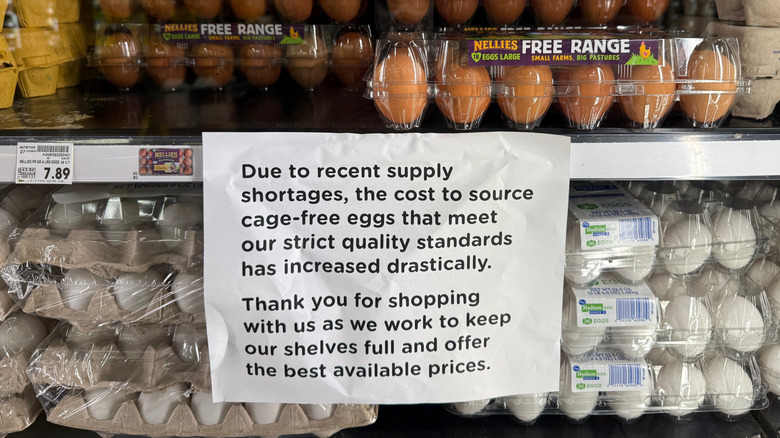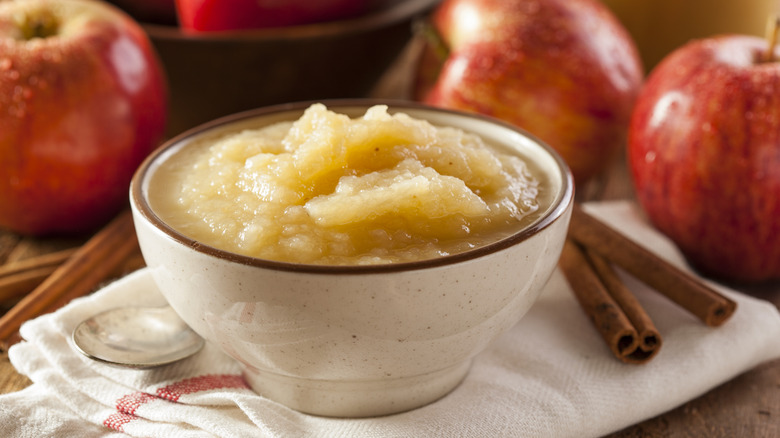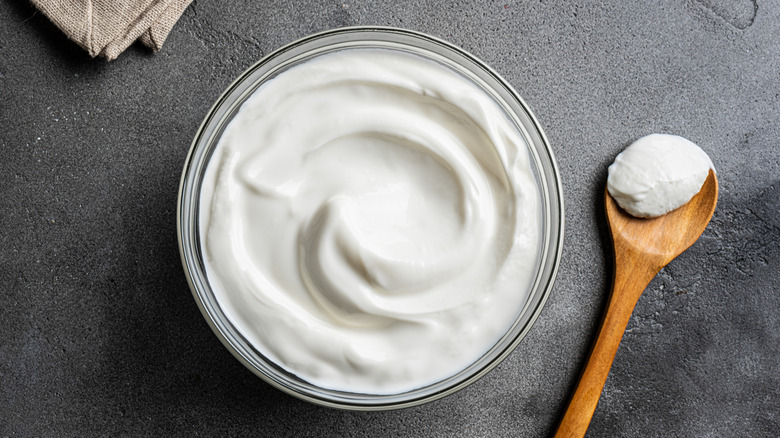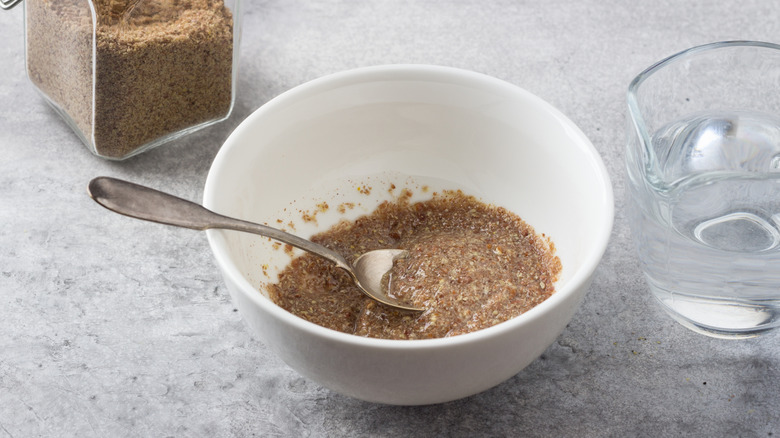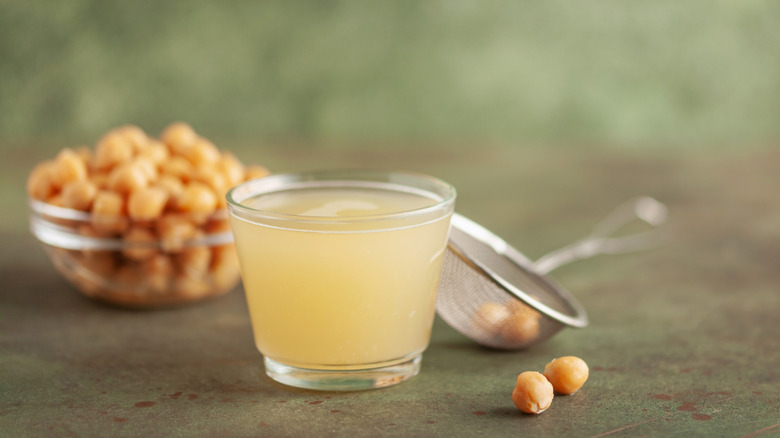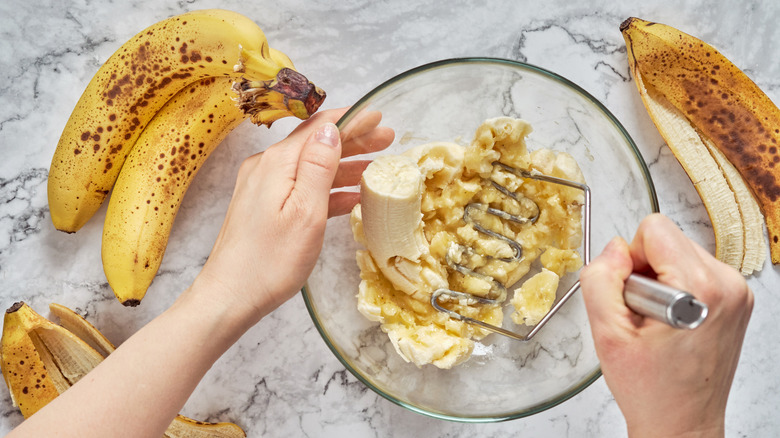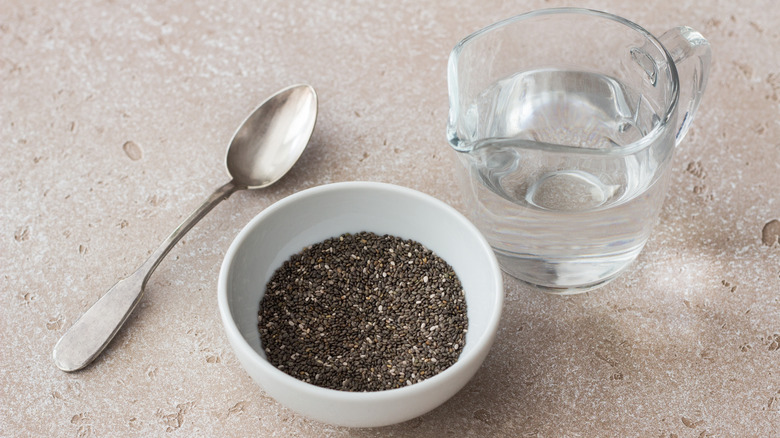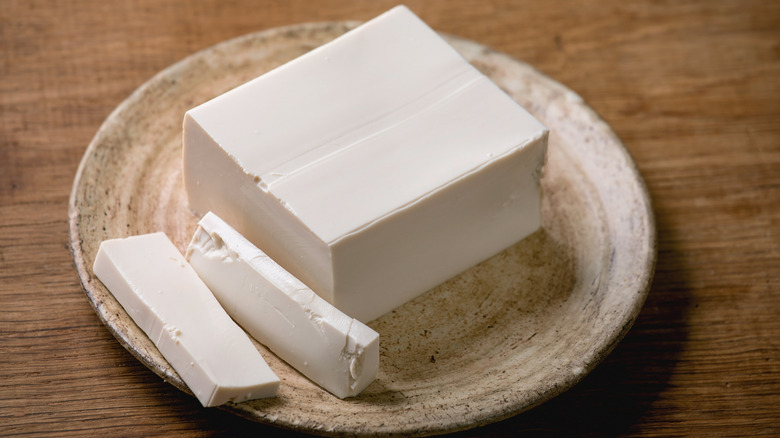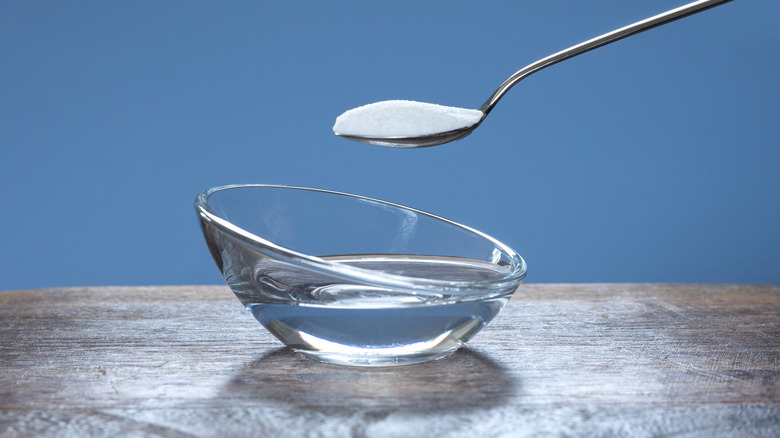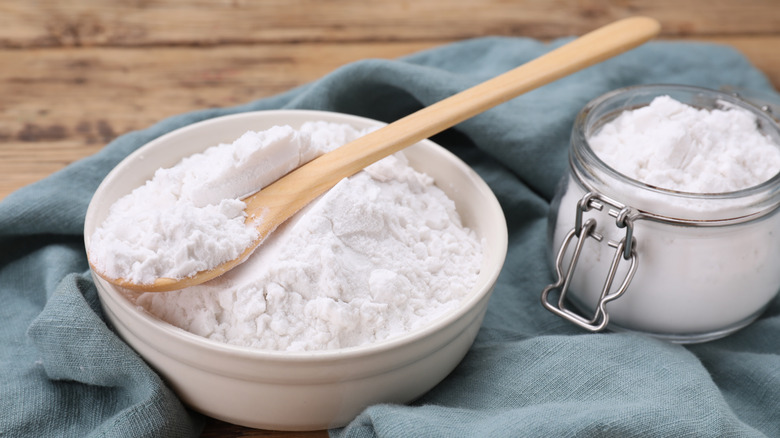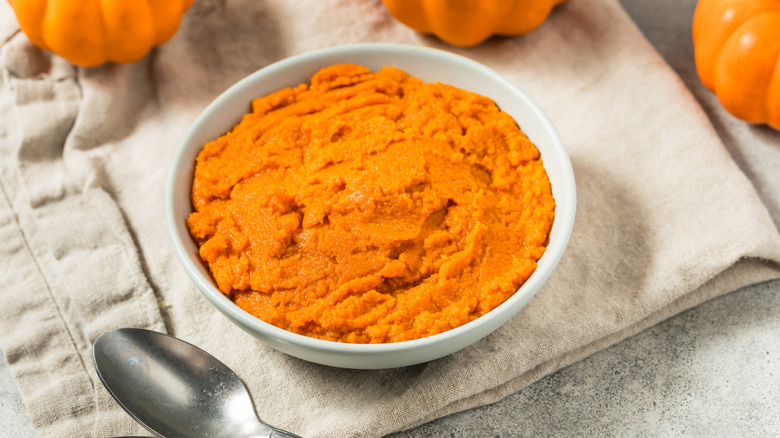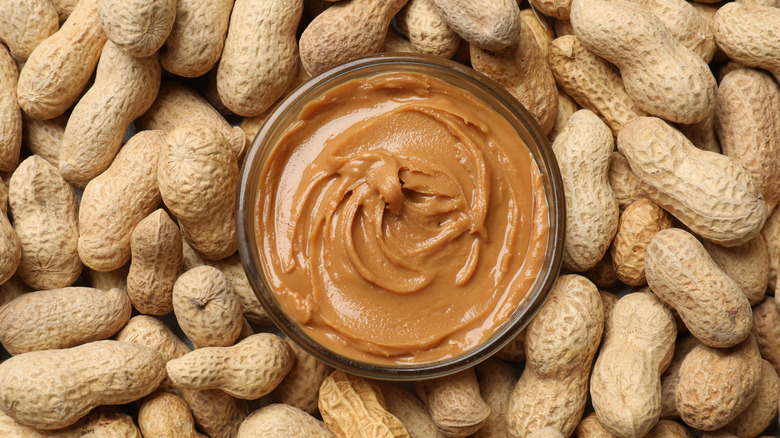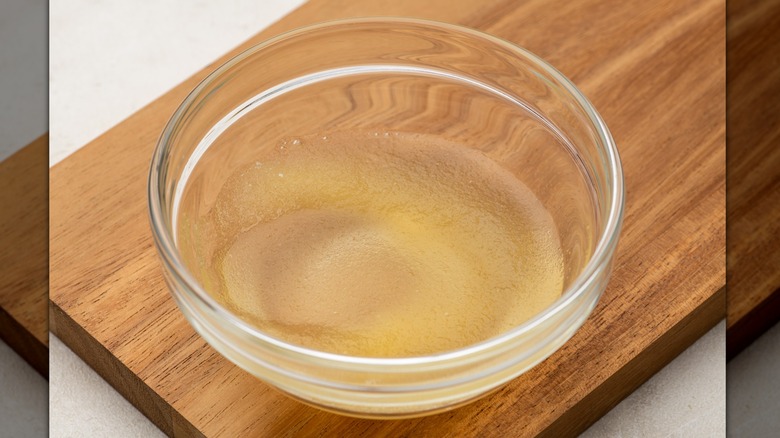Eggs Too Expensive? Try These 13 Substitutes For Baking
Experiencing sticker shock in the egg aisle? You're not alone. Egg prices seem to be soaring, with many bakers searching for less expensive alternatives. Luckily, you don't have to give up those precious pastries or scrumptious cakes. There are plenty of budget-friendly egg substitutes that work just as well.
To find the perfect replacement, you have to understand why eggs are so important in baking. They don't solely add flavor — eggs are serious multitaskers. They give structure to your brownies and muffins, create that heavenly fluff in angel food cake, and provide satisfying density in custards. This magic is partly due to their composition: Egg whites are 88% water and egg yolks are 50% water, adding crucial moisture to your baked goods. The protein in eggs works as a natural binder, keeping ingredients together, while the yolks contain lecithin, a natural emulsifier that blends ingredients that typically don't mix well, like water and fat.
Whether a recipe calls for the whites, yolks, or whole eggs, you can't simply skip them. You need to replace them wisely by choosing the right substitute for your specific need. After all, baking comes down to chemistry and you must use the right replacement in the correct proportions to achieve the desired result. Luckily, we have plenty of suggestions that should suit both your recipe and your budget.
Applesauce
Applesauce isn't just a healthy kids' snack; it's an excellent egg substitute. This smooth purée typically costs around $3 per 46-ounce jar, which works out to roughly $0.13 per "egg" replacement. The price of eggs varies greatly but you'd be hard-pressed to find them for this cheap. And unlike eggs, an unopened jar of applesauce has a long shelf life, so you can store it in your pantry until you're ready to bake. When that time comes, you only need a quarter cup of unsweetened applesauce per egg.
Although it seems wildly different, applesauce has similar properties to eggs. It contains pectin, a sugar that functions as a natural binder. However, it doesn't work as a leavening agent, so instead of a fluffy texture, applesauce will make baked goods denser. If you prefer to maintain a lighter consistency, offset the sauce with half a teaspoon of baking powder.
Since applesauce adds moisture and subtle fruitiness to your baked goods, we recommend using it in recipes where apples will naturally complement the other flavors. Baked goods that are dense, sweet, and moist work best. Think brownies, muffins, and rich cakes like a decadent carrot cake. Applesauce also makes a great vegan egg substitute in boxed cake mixes. Avoid airy pastries like angel food cake and anything that relies on the texture of whipped egg whites — like meringues.
Yogurt
If you run out of eggs when cooking, grab a yogurt from the fridge. A ¼ cup of plain yogurt replaces one egg. Always stick to plain, and sweetened varieties to not overpower the flavors of your baked goods. While you can opt for any brand of regular yogurt, Greek varieties add more protein and richness. Since yogurt is naturally creamy and slightly acidic, it'll also bring moisture and tanginess. As such, we recommend using it in recipes that could use a slight sourness like cakes or cookies with fruits and warm spices.
Like applesauce, yogurt doesn't have the leavening power of eggs. However, the acidic nature of yogurt activates other leavening agents. Although both leavening agents, the difference between baking soda or baking powder is that baking soda doesn't contain acid while baking powder does. In conjunction with yogurt, either will help those baked goods rise, so consider adding a pinch to your recipe.
Flaxseed
Are you craving a vegan egg substitute that's packed with nutrition? Look no further than flaxseed. Ground flaxseed mixed with water creates a gel-like substance that works surprisingly well in baking. Although flaxseed might seem more expensive than eggs, it's cost-effective in the long run since a little bit goes a long way and stays fresh for months when stored properly.
To use the seeds in place of eggs, you'll need to create what bakers call a "flax egg." For every tablespoon of ground flaxseed, add 2 tablespoons of water and stir well. Let it sit for roughly 15 minutes until it creates a gooey consistency, reminiscent of raw eggs.
If you're a flax seed fan, you know it has a nutty, earthy flavor. This may be too powerful for delicate pastries. However, it can complement recipes that already contain nuts or whole wheat flour. It also works surprisingly well with stronger spices like cinnamon and nutmeg. And aside from its satisfying flavor, you'll get an extra dose of nutrients since flaxseeds pack healthy omega-3 fatty acids and fiber.
Aquafaba
Aquafaba sounds like a fancy, high-end ingredient. But truth be told, you might already have it in your cupboard. If you drain a can of chickpeas, the liquid you collect is aquafaba! And whatever you do, don't go tossing it down the sink. Aquafaba can be used in a variety of ways, namely as an egg substitute.
So what makes aquafaba stand out from other alternatives on this list? It can replace whole eggs, but where it really shines is as an egg white substitute. Like egg whites, it contains albumin and globulin, which enable it to be whipped or foamed. And thanks to another chemical compound called saponin, it maintains this foamy consistency well. Most egg replacements fall short in this department. So, for recipes that rely heavily on egg whites like meringues or macarons, opt for aquafaba.
Three tablespoons of aquafaba stand in for one whole egg (or one for the yolk and two for the whites). Aquafaba should resemble the consistency of eggs. If it's too watery, reduce it in a saucepan until it reaches the desired viscosity, letting it cool before adding it to recipes. If whipping the aquafaba, expect it to take longer than it would for eggs. And finally, pay attention to whether your chickpeas come salted or not. Salted aquafaba isn't necessarily a bad thing, but adds a savory touch to your baked goods.
Mashed banana
If you've ever mashed a banana, you know the result is reminiscent of a sticky pudding. Luckily, this texture adds moisture and substance, just as eggs would. As a fruit, it also adds natural sweetness, fiber, and nutrients. If you don't like your baked goods overly sweet, go easy on the added sugar and let the banana do the work.
While they make a good substitute, they impart a slight banana flavor, so make sure it complements the other ingredients. Think cakes, muffins, brownies, and sweeter breads or breakfast foods. We'd skip the quiche since bananas wouldn't add that savory element and aren't packed with protein.
Ripe bananas work best, and the amount depends on size. Generally, speaking, you can swap one small banana per egg in recipes. To be more precise, ¼ cup mashed banana should equal an egg. Just peel and place whole bananas in a large bowl and using a potato masher, pastry blender, or fork, work your fruit into a uniform, pudding-like consistency. Basically, it's baby food.
Chia seeds
Just as you can make a flax egg, you can also make a chia egg. To make the equivalent of one egg, mix 1 tablespoon of seeds with 2½ tablespoons of warm water. Stir and let sit for 15 minutes. The timing varies, but ultimately, you want the liquid to thicken to the consistency of egg whites. Some home cooks let the mixture sit in the fridge for up to two hours before adding it to recipes. For a richer flavor, add a tiny bit of vegetable oil.
Since this liquid is gelatinous, it functions as a thickener and a binder and can contribute a satisfying pudding-like texture. Mind you, chia eggs don't function as emulsifiers or leavening agents. Since it won't blend ingredients or help the dough rise, use it in select recipes. Cookies, quick breads, pancakes, and muffins are good options for chia eggs, but leave the meringue and angel food cake for other substitutes.
Silken tofu
The aptly named silken tofu is soft and smooth, almost custard-like. This texture blends seamlessly in baked goods. Thanks to its neutral flavor and water content, it's extremely versatile, adding moisture and substance without altering the original recipe too much.
You can find silken tofu in most grocery stores — in the refrigerated section by other tofu items or international products. To replace one egg, use a ¼ cup of silken tofu. For even easier mixing, we recommend using puréed tofu. Blend it until it's smooth so you don't encounter unexpected lumps while mixing your ingredients — or worse yet, in your baked goods. If blending by hand, push it through a fine mesh strainer for an ultra-smooth consistency.
Silken tofu is successful at binding and thickening baked goods, but won't help them rise. It's ideal for when you're seeking moisture and density in recipes. Think moist chocolate cake, creamy pies, or custard. Unlike several items on this list, it doesn't have much sweetness so it also does well in savory dishes like vegetable tarts.
Baking soda and vinegar
Combining baking soda and vinegar might sound like a grade-school science experiment, but when it comes to egg replacements, it works. This dynamic duo functions as a leavening agent, meaning it can help that dough rise. One is a base and the other an acid, and when combined, the reaction creates bubbles that make baked goods expand into an airy, appetizing texture.
For one egg, combine 1 teaspoon of baking soda and 1 tablespoon of vinegar. Apple cider or white distilled vinegar are commonly used. Mix these ingredients separately before adding them with the rest, or your baked goods might look more like a science experiment gone bad. If your recipe already calls for significant baking soda, this substitute may not be the best option since excessive baking soda causes baked goods to expand quickly and then fall.
Assuming you're not overdoing it in the baking soda department, this replacement will give a nice lift to fluffy dinner rolls and airy scones. Pizza dough also benefits from this egg substitute, which creates a lighter crust with delightful air pockets. However, despite this combo's ability as a leavening agent, it doesn't bind ingredients or thicken recipes. If needed, consider adding another egg substitute, like applesauce or silken tofu, to fill in these gaps.
Cornstarch
The beauty of cornstarch is that it's flavorless. So if you're looking for an egg substitute that won't impact the overall taste of a dish, it's a solid option. Plus, it's extremely cheap and lasts for ages. You likely already have a box of cornstarch sitting in the back of your pantry.
Most people think of cornstarch as a thickener in sauces and gravies, but it serves the same purpose in baked goods. It also works as a binding agent, keeping those precious pastries intact. Aim for recipes where these qualities will shine like shortbread cookies or pie crusts. Avoid foods that require an eggy flavor like custards or quiches.
Mix 2 tablespoons of cornstarch with 3 tablespoons of cold water to replace one egg. Always use cold water rather than warm to create a cornstarch slurry. When cornstarch hits hot ingredients, it tends to clump up. You should also make sure to whisk your slurry together thoroughly to create a gel-like consistency before adding it to your recipe. Cornstarch clumps don't have much flavor, but the texture is definitely off-putting.
Canned pumpkin
Can't get enough pumpkin? We've got good news! Canned pumpkin isn't just for fall baking, it can be used year-round as an egg substitute. And if you love that pumpkin flavor, adding it to baked goods is a clever way to enjoy it throughout the seasons. It provides a subtle earthiness that enhances many recipes without being overwhelming.
A ¼ cup of pure canned pumpkin counts as one egg. Make sure you're not reaching for pumpkin pie filling instead — while it's delicious, your baked goods will taste far sweeter than you bargained for. Pure pumpkin is sweet enough as is, so you may want to scale back the sugar. Considering its high moisture content, reducing other liquids in the recipe is also a good idea. Alternatively, you could strain your canned pumpkin to eliminate some moisture.
What recipes work best with pumpkin? Consider the other flavors. Pumpkin pairs perfectly with warm spices like cinnamon and nutmeg. It makes a delicious addition to banana bread and coffee cake and it also adds an interesting depth to oatmeal cookies and whole wheat bread. Avoid canned pumpkin in doughs that need to rise — or supplement with baking soda. And considering pumpkin's deep orange hue, be mindful that it'll impact light-colored cakes and pastries.
Nut butters
Nut butters aren't just for sandwiches; they're surprisingly effective egg replacers that add rich flavor along with protein and fat to baked goods. They also work well for vegans and — assuming you get unsweetened jars — those avoiding added sugars.
For each egg, use 3 tablespoons of nut butter. You can choose from a variety, although rumor has it almond, cashew, and peanut butter work best. To narrow down your options, check out our list of the top 10 peanut butter brands. Regardless of which you choose, we recommend opting for natural varieties without added oils or sugars, so you don't get an imbalance of flavors. We also suggest using creamy over crunchy since smooth varieties blend more easily. In natural nut butter, oil tends to separate. Give it a good stir before adding it to your recipe. If your nut butter is stiff, warming it slightly will make it easier to work with.
Nut butters are obviously nutty! So consider the flavor before adding it to baked goods. Peanut butter goes exceptionally well with chocolate or banana-based recipes, while almond butter's milder flavor may be better suited for delicate pastries. And if you've ever taken a spoonful of nut butter from the jar, you know just how dense it is. As such, we'd avoid using this egg substitute in light, airy baked goods. If you still want to use it but crave a lighter consistency, add an extra tablespoon of liquid to your recipe.
Gelatin or agar-agar
When corn starch, chia seeds, and flaxseed are mixed with water, they all develop a gelatinous texture. But why not kick it up a notch with real gelatin? Gelatin, or its plant-based cousin agar-agar, is the epitome of a gel-like substance. This structure mimics certain properties of eggs in baking, namely by holding your baked goods together.
To use gelatin as an egg replacement, mix one tablespoon of unflavored gelatin with 1 tablespoon of lukewarm water. Add two more tablespoons of hot water and stir. Let it sit until it thickens, although there's no need to wait till it turns into full-on jello. Agar-agar follows similar instructions, although you only need 1 tablespoon of powder mixed with 1 tablespoon of water. Heat it until it's dissolved then cool before use.
These substitutes work well in recipes where eggs function as binders. The end result may be quite firm, which can be a good thing. Think chewy cookies, dense cakes, or as a rich filling in pot pies. Also, unflavored gelatin and agar-agar are virtually tasteless, so they won't impart any flavors to your baked goods. But like several other items on our list, these substitutes don't have leavening abilities. If you're making sponge cakes or soufflés, stick to aquafaba or liquid egg whites.
Carbonated water
If you're running low on baking ingredients, but have soda water, you're in luck. Whether you call it seltzer, soda, or sparkling water, carbonated water doubles as an egg substitute thanks to its bubbly nature. Those small air pockets transfer to baked goods, creating lighter pastries while the water contributes significant moisture. Carbonated water doesn't have much if any flavor, providing a neutral replacement. And if you're cutting back on calories, water has none.
A ¼ cup seems to be the magic amount for egg substitutes, including carbonated water. However, don't expect fizzy water to meld all those ingredients together; you'll need other binders and emulsifiers for that. Milk, butter, glutinous flours, and gelatin are common binders while lecithin, gums, and fatty acids are emulsifiers. Alternatively, you can pick a different egg replacement from this list and replace regular water with soda for fluffy box mix cake.
